Abstract
In concentrated solar power (CSP) systems, structural materials face severe corrosion challenges induced by molten chlorides, with the corrosion severity being highly dependent on the salt composition. This study systematically compares the corrosion behavior of two representative superalloys, Inconel 625 and SS321, in binary NaCl–KCl and ternary MgCl2–NaCl–KCl molten salts at 700 °C. The corrosion products and microstructural features were characterized using X-ray diffraction (XRD), scanning electron microscopy (SEM) equipped with energy-dispersive spectroscopy (EDS), and electron backscatter diffraction (EBSD), in combination with static exposure tests to elucidate the underlying mechanisms. The results show that in NaCl–KCl molten salts, both alloys primarily form Cr2O3 as the protective product. However, the corrosion scale of SS321 is porous, whereas Inconel 625 develops a dense NiCr2O4 inner layer, exhibiting superior corrosion resistance. In the MgCl2–NaCl–KCl molten salt system, Cr2O3 is replaced by a dense MgO layer forms on Inconel 625, coupled with Mo surface enrichment, which significantly inhibits Cr depletion and leads to a notably reduced corrosion rate relative to the binary salt. In contrast, the transformation of Cr2O3 on SS321 into porous MgCr2O4 exacerbates intergranular corrosion, resulting in a substantial degradation of corrosion resistance. This study elucidates the distinct corrosion pathways and mechanisms of different alloys in binary and ternary chloride salts, providing important guidance for the selection of molten salt compositions and corrosion-resistant structural materials in CSP applications.
1. Introduction
Solar energy is a clean energy source with broad development prospects, and the construction of efficient and stable thermal energy storage systems is a key factor driving the advancement of concentrated solar power (CSP) technology [,,,,,]. Conventional CSP systems primarily employ nitrates and carbonates as storage media, but their operating temperatures remain below 700 °C, accompanied by limitations such as low enthalpy of fusion and poor thermal conductivity [,,]. Chloride molten salts (e.g., MgCl2–KCl–NaCl), owing to their high thermal stability (exceeding 800 °C), low cost (approximately 0.35 USD/kg []), and excellent thermophysical properties, are regarded as promising candidates for next-generation CSP systems and are designated as a priority research target by the U.S. Department of Energy under the SunShot Initiative [].
In the design of molten salt systems, the composition of the salts exerts a decisive influence on their thermophysical properties, among which specific heat capacity is a key parameter for evaluating heat storage capacity and heat transfer efficiency [,,]. Studies show that in the binary NaCl–KCl molten salt, the specific heat capacity reaches its maximum when the two salts are mixed at a 1:1 molar ratio, which enhances thermal storage efficiency []. In the NaCl–KCl–MgCl2 ternary system, a molar ratio of 1:1:3 not only provides a lower eutectic melting point but also ensures a favorable balance of thermal stability, specific heat capacity, and cost-effectiveness []. However, impurities in chloride salts (e.g., moisture) and decomposition reactions of molten salts are the primary factors responsible for metal corrosion. Particularly at elevated temperatures (500–800 °C), hygroscopic chlorides such as MgCl2 and ZnCl2 readily absorb moisture. Upon heating, their hydrated compounds undergo dehydration and hydrolysis, releasing HCl, which is the main corrosive species. In some cases, HCl can further react with residual oxygen/oxides to produce Cl2, thereby accelerating the corrosion of pipelines [,,].
With the rapid deployment of high-temperature molten salt storage technology in concentrated solar power (CSP) systems, conventional commercial high-temperature alloys (e.g., Ni-based alloys and stainless steels) are widely used in extreme energy environments [,,,,]. Inconel 625, as a representative commercial Ni-based high-temperature alloy, exhibits excellent creep resistance and oxidation resistance under high-temperature conditions, with a maximum service temperature of up to 980 °C [,,]. SS321 stainless steel, as a typical austenitic heat-resistant steel, demonstrates good microstructural stability and high-temperature strength within the range of 600–800 °C [,]. However, chloride molten salts exhibit strong chemical reactivity at elevated temperatures, causing selective dissolution of alloying elements and accelerated diffusion, which significantly reduces the corrosion resistance of high-temperature alloys and compromises their structural stability and mechanical properties [,]. In addition to chlorination and selective leaching, high-temperature oxidation also plays a critical role in the degradation of metallic materials in molten chlorides. The competitive reactions between oxidation and chlorination often lead to the formation and subsequent breakdown of protective oxide films such as Cr2O3 or NiO, resulting in the exposure of fresh metal surfaces and the propagation of internal oxidation fronts. This cyclic oxidation–chlorination mechanism has been identified as one of the dominant failure modes under chloride-rich conditions []. Existing studies mainly focus on the corrosion behavior of Ni-based alloys in single-salt systems. Lee U et al. report that Hastelloy C-276 exhibits superior corrosion resistance compared with SS316L and Ni-based N10003 in unpurified molten NaCl–KCl salt at 800 °C, which is attributed to its higher Cr and Mo contents that facilitate the formation of a dense Ni–Mo–Cr enriched surface layer. This protective layer effectively restricts metal ion migration and suppresses further alloy degradation []. Similarly, Liu et al. investigate the static immersion of four Ni-based alloys in NaCl–MgCl2–KCl ternary molten salt at 700 °C for 100 h under vacuum, and find that Inconel 625 exhibits the best corrosion resistance. Their results indicate that SS304 and SS316L suffer the most severe corrosion, followed by Inconel 800H, while Inconel 625 shows the least mass loss []. Similar results have been reported by Zhang et al., who demonstrated that salt impurities (e.g., HCl, Cl2) accelerate corrosion by promoting oxidation-assisted chlorination, leading to the breakdown of protective Cr2O3 films and rapid grain boundary attack []. At present, comparative studies on the corrosion behaviors of Inconel 625 Ni-based alloy and SS321 austenitic stainless steel in binary and ternary chloride molten salts remain insufficient. In particular, the influence of molten salt composition on the mechanisms of grain boundary selective dissolution and oxide film stability has not yet been systematically elucidated.
Unlike previous studies that mainly focused on single-component metals or individual alloys, this work systematically compares the corrosion behaviors of two widely used commercial superalloys (Inconel 625 and SS321) in both binary and ternary chloride molten salts at elevated temperatures. Therefore, this study selects binary NaCl–KCl (1:1 molar ratio) and ternary NaCl–KCl–MgCl2 (1:1:3 molar ratio) molten salts as corrosive media to simulate representative chloride salt environments at 700 °C. Through immersion corrosion tests, the work systematically investigates the microstructure, corrosion pathways, and oxide characteristics of Inconel 625 and SS321, with a particular focus on how salt composition governs corrosion mechanisms. The findings provide important guidance for the selection of molten salts in CSP systems and for evaluating the in-service performance of commercial high-temperature alloys in molten salt environments.
2. Experimental Methods
2.1. Materials Preparation
The experimental materials used in this study primarily consist of plate-form Ni-based alloy Inconel 625 and stainless steel SS321, and their chemical compositions (wt.%) are listed in Table 1.

Table 1.
Chemical compositions of Inconel 625 and SS321 alloys (wt.%).
The samples are first degreased with acetone, then mechanically polished sequentially using #400 to #2000 SiC sandpapers. After polishing, they are ultrasonically cleaned in deionized water and anhydrous ethanol, dried, and stored in a desiccator for subsequent use [,]. For the molten salts, 900 g of NaCl–KCl (1:1 mol%) and MgCl2–NaCl–KCl (3:1:1 mol%) salts are weighed and placed in alumina crucibles. The crucibles are then dried in a box-type atmospheric furnace at 120 °C under high-purity argon for 48 h to remove moisture and achieve thermal purification.
To investigate the thermophysical properties and cost of the salts, NaCl–KCl (1:1 mol%) and NaCl–KCl–MgCl2 (1:1:3 mol%) are surveyed, with the results summarized in Table 2. The binary NaCl–KCl salt exhibits a relatively high melting point of approximately 657 °C, but a 1:1 molar ratio achieves the maximum specific heat capacity, which benefits thermal storage efficiency. This salt is low-cost, chemically stable at moderate temperatures, and, due to its low hygroscopicity, presents relatively mild corrosivity toward structural metals under high-temperature conditions. In contrast, the NaCl–KCl–MgCl2 mixture shows a significantly reduced eutectic melting point (~385–430 °C), while offering higher thermal stability and superior specific heat capacity, making it more suitable for next-generation high-temperature CSP systems. However, the MgCl2 component is highly hygroscopic and readily generates corrosive species such as HCl in the molten salt, which can accelerate the corrosion of metallic components [].

Table 2.
Properties and prices of two molten salts as TES/HTF in CSP.
2.2. Exposure Test
The static corrosion testing setup is shown in Figure 1. Crucibles containing either NaCl–KCl or MgCl2–NaCl–KCl molten salts and the samples are placed at the bottom of the furnace, while a suspension rack is fixed at the top. The samples are hung using Mo wires and electrically insulated by alumina tubes to prevent galvanic corrosion. Experiments are conducted under high-purity argon (≥99.999%, O2/H2O < 1 ppm, flow rate 50 mL/min) [,]. The furnace is heated to 820 °C to fully melt all salt components and then cooled to 700 °C for testing. Samples are immersed into the molten salts to a preset depth for 250 h. After exposure, the furnace is allowed to cool to room temperature, and the samples are retrieved, desalted with deionized water, and dried in a vacuum oven for storage.
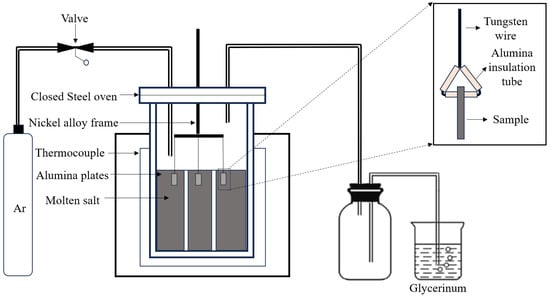
Figure 1.
Schematic diagram of experimental set-up for immersion test and the sample holder with alloys samples.
After the corrosion tests, residual molten salts are removed by immersing the samples in a descaling solution composed of 50 mL HCl, 50 mL deionized water, and 2 g hexamethylenetetramine. The samples are treated in an ultrasonic cleaner to remove corrosion products. Following ethanol rinsing, the samples are dried, and the process is repeated until the sample mass stabilizes. The final mass is measured using an analytical balance, and the corrosion rate is calculated according to Equation (1).
where is the dimensionless constant (8.76 × 107), represents the mass change per unit area (g/cm2), is the material density (g/cm3), is the isothermal exposure time (h). The densities of Inconel 625 and SS321 are 7.93 g/cm3 and 8.44 g/cm3, respectively.
2.3. Characterization Methods
Elemental distributions in the microstructure are characterized using a field-emission electron probe microanalyzer (EPMA-8050G, Shimadzu Corporation, Kyoto, Japan) at an accelerating voltage of 15 kV and a beam current of 50 nA. The surface and cross-sectional morphologies of the corroded samples are examined using a scanning electron microscope (Apreo S HiVac SEM, Thermo Fisher Scientific Corporation, Waltham, MA, USA) operated at 20 kV and 13 nA. Surface elemental compositions and mass fractions are determined via the accompanying energy-dispersive spectrometer (EDS). The phase structures of the corrosion products are identified using X-ray diffraction (SmartLab SE, Rigaku Corporation, Tokyo, Japan) with Cu Kα radiation over a 2θ range of 10°–90°.
3. Results
3.1. Microstructure Characterization
To investigate the microstructural characteristics of Inconel 625 and SS321 alloys, electron backscatter diffraction (EBSD) is employed to systematically analyze their grain boundary distribution and stress state. As shown in the EBSD results in Figure 2, Inconel 625 exhibits relatively large and uniformly distributed grains with predominantly high-angle grain boundaries and low boundary stresses, whereas SS321 shows smaller, unevenly distributed grains with localized stress concentrations at certain grain boundaries. These local stress concentrations can act as preferential sites for the initiation of intergranular corrosion, as they enhance atomic diffusion and create regions of higher chemical reactivity []. Under aggressive molten salt conditions, such stress-concentrated regions are more susceptible to selective dissolution, facilitating the propagation of corrosion along grain boundaries and contributing to the observed differences in corrosion behavior between the two alloys.
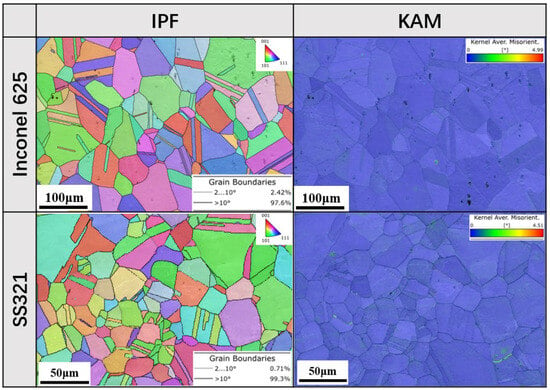
Figure 2.
Electron backscatter diffraction analysis of the initial Inconel 625 and SS321 alloy samples.
3.2. Corrosion Rate
To evaluate the influence of molten salt composition on alloy corrosion resistance, Figure 3 presents the corrosion rates of Inconel 625 and SS321 after exposure to molten NaCl–KCl and MgCl2–NaCl–KCl at 700 °C for 250 h. The corrosion rate of Inconel 625 reached 786.30 µm/y in the binary NaCl–KCl salt but sharply decreased to 85.71 µm/y in the ternary MgCl2–NaCl–KCl salt, whereas SS321 exhibited much higher corrosion rates of 2143.38 µm/y and 2835.51 µm/y, respectively. The results show that, in both salt systems, the corrosion rate of Inconel 625 is significantly lower than that of SS321, indicating superior stability of Inconel 625 in chloride melts. For SS321, the corrosion rate in the binary salt is slightly lower than in the ternary salt, but remains relatively high, confirming its poor corrosion resistance in both environments. In contrast, Inconel 625 exhibits a higher corrosion rate in the binary salt but shows a pronounced decrease in the more aggressive ternary salt. These observations suggest that variations in molten salt composition influence the protective effectiveness of corrosion product films, while differences in alloy composition and microstructure further affect corrosion pathways. The underlying mechanisms are discussed in detail in subsequent sections.
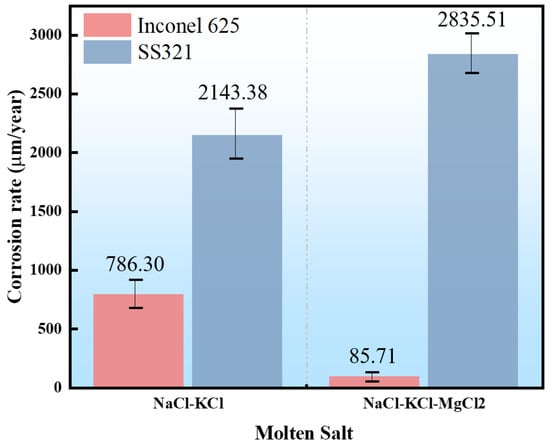
Figure 3.
Corrosion rates of Inconel 625 and SS321 alloys exposed to different molten chlorides at 700 °C for 250 h.
3.3. Corrosion Product Analysis
To elucidate the composition of corrosion product films, XRD analyses are performed on corroded samples. Figure 4 presents the XRD patterns of Inconel 625 and SS321 after exposure at 700 °C to molten NaCl–KCl and MgCl2–NaCl–KCl for 250 h. For Inconel 625, the primary corrosion product in the binary salt is Cr2O3, indicating that Cr undergoes preferential oxidation. In contrast, the corrosion products in the ternary salt is dominated by MgO, with no detectable Cr2O3. Compared with the stable presence of Cr2O3 in the binary system, this suggests that Cr2O3 is unstable in the ternary salt, likely due to reaction with the abundant Mg2+ in the melt. For SS321, the main corrosion products in the binary salt are Cr2O3 and Fe3O4, showing characteristic of typical oxidation behavior. In the ternary salt, however, the corrosion products consist of primarily MgO and the MgCr2O4 spinel phase, indicating that the initially formed Cr2O3 reacts with MgO in the MgCl2-containing melt to form the thermodynamically stable MgCr2O4.
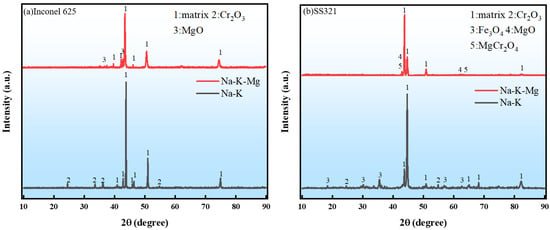
Figure 4.
XRD patterns of two alloys after exposure in molten chlorides at 700 °C. (a) Inconel 625; (b) SS321.
3.4. Corrosion Morphology
To further elucidate the corrosion mechanisms of the two alloys in high-temperature molten salts, SEM/EDS characterizations are conducted on the corroded surfaces and cross-sections. Comparative analyses are carried out to examine elemental distributions, microstructural evolution, and corrosion morphologies.
3.4.1. NaCl–KCl Binary Molten Salts
Figure 5 and Figure 6 present the surface SEM images and EDS elemental maps of Inconel 625 and SS321 alloys after exposure to molten NaCl–KCl at 700 °C. The point analysis results of Figure 5 are summarized in Table 3. As shown in Figure 5a, after 250 h of corrosion, the corrosion product layer of Inconel 625 exhibits a bilayer structure. The outer layer consists of coarse particles with diverse morphologies, including rhombic, flake-like, and granular shapes (Figure 5a-A), while the inner layer is composed of densely packed fine particles (Figure 5a-B). The matrix region in Figure 5a-C is enriched in Ni with a small amount of Cr, indicating slight oxidation. The SEM/EDS results in Figure 6a and the analyses at points 1 and 3 in Table 3 indicate that the outer corrosion products are mainly composed of Cr2O3 with minor Fe oxides, whereas the inner layer consists primarily of NiCr2O4. The small fraction of Fe oxides and NiCr2O4 phase is masked by the dominant Cr2O3, making them difficult to detect in the XRD patterns (Figure 4). Point 2 analysis further reveals the presence of Fe and Ni within the outer particle layer, suggesting that the Cr2O3 scale on the surface does not effectively suppress the outward diffusion of substrate elements.
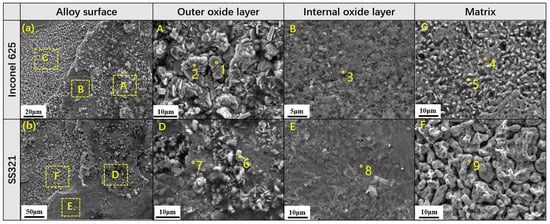
Figure 5.
SEM surface morphology characterization of alloys in NaCl–KCl molten chlorides at 700 °C (a) Inconel 625; (b) SS321.
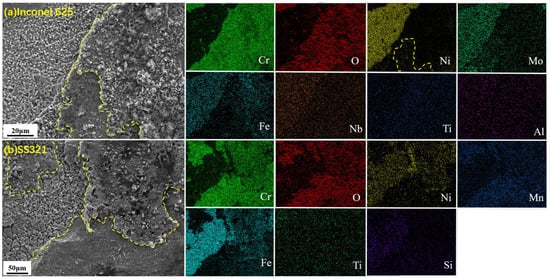
Figure 6.
EDS of surface morphology characterization of alloys in NaCl–KCl molten chlorides at 700 °C. (a) Inconel 625; (b) SS321.

Table 3.
EDS Point scanning of alloys in molten chlorides at 700 °C in Figure 5 (at%).
As shown in Figure 5b, the corrosion product layer on SS321 also exhibits a bilayer structure. The outer layer is composed of rhombic particles (Figure 5b-D), while the inner layer consists of a dense oxide layer (Figure 5b-E). The matrix region (Figure 5b-F) is enriched in Fe, with minor amounts of Ni and Cr. The SEM/EDS results in Figure 6b and the analyses in points 7 and 8 in Table 3 indicate that the outer corrosion products are mainly composed of Cr2O3, Fe3O4, and a small fraction of NiO, whereas the inner layer primarily consists of Cr2O3 with minor Fe3O4 and Mn oxides. Since NiO is present in small content and intermixed with Cr2O3, it cannot be clearly detected in the XRD patterns shown in Figure 4.
Figure 7 shows the cross-sectional EDS maps of Inconel 625 and SS321 alloys after exposure to molten NaCl–KCl at 700 °C. No continuous oxide layers are observed on the alloy surfaces. According to the selective oxidation behavior of multicomponent alloys, the initially formed Cr2O3 film tends to crack and spall due to thermal expansion mismatch, making it difficult to observe an intact oxide scale in the cross-sections []. The cross-sectional results reveal pronounced intergranular corrosion in both alloys. For Inconel 625, the grain boundaries are dominated by Cr-depleted white regions and the intergranular corrosion depth reaches 123 µm, indicating that the alloy remains in the early stage of selective oxidation and dissolution without the formation of continuous penetration channels. In contrast, black corrosion channels penetrating along the grain boundaries of SS321, exhibiting a greater corrosion depth of 156 µm. As shown in Figure 2, the formation of these black channels is likely associated with stress concentration at the grain boundaries. This demonstrates that corrosion has not only advanced in depth but also disrupted the continuity of the grain boundary structure. This explains why the difference in intergranular corrosion depth between the two alloys is relatively small, while their corrosion rates differ significantly.
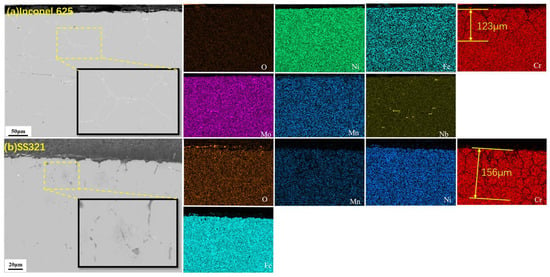
Figure 7.
SEM cross-section morphology characterization of alloys in NaCl–KCl molten chlorides at 700 °C. (a) Inconel 625; (b) SS321.
Combining the surface and cross-sectional characterizations, both alloys form a typical bilayer corrosion product structure after exposure, indicating that their corrosion behavior is governed by multi-stage reactions. The bilayer corrosion products on Inconel 625 provide partial protection, but the Cr2O3 layer cannot effectively prevent the outward diffusion of Fe and Ni, leaving migration pathways for corrosion species. In contrast, the bilayer oxides on SS321 are more heterogeneous and exhibit poorer protective capability, suggesting more severe and complex corrosion progresses. Although the intergranular corrosion depths of the two alloys are comparable, their corrosion morphologies and characteristics differ significantly. Owing to the stabilizing effect of Ni and Mo, Inconel 625 retains part of structural integrity after 250 h of corrosion, whereas SS321 rapidly undergoes grain boundary rupture, resulting in accelerated failure. In summary, both alloys experience surface oxidation and intergranular corrosion in molten salts; however, Inconel 625 follows a slower and more stable corrosion evolution, while SS321 exhibits more aggressive behavior driven by intergranular corrosion.
3.4.2. NaCl–KCl–MgCl2
Figure 8 and Figure 9 present the surface SEM images and EDS elemental distribution analyses of Inconel 625 and SS321 alloys after exposure to molten MgCl2–NaCl–KCl salt at 700 °C, while Table 4 summarizes the EDS results of the marked points in Figure 8. As shown in Figure 8a, after 250 h of corrosion, the surface of Inconel 625 is covered with corrosion products mainly composed of irregularly sized rhombic particles. In region A of Figure 8a, particle-like corrosion products with diameters of approximately 5–20 μm are sparsely distributed on the oxide layer surface. Based on the EDS results in Figure 9a and points 1 and 2 in Table 4, these particles are primarily MgO. In region B of Figure 8a, the substrate surface is partially covered by oxides. According to the results at points 3, 4, and 5 in Table 4, these oxides are mainly composed of Fe, Ni, and Mg containing compounds. In addition, the atomic ratios at points 3 and 5, combined with the EDS characterization in Figure 9, indicate that the metallic elements are present at significantly higher levels than oxygen. This suggests that, apart from a small amount of oxides, metallic Fe and Mo are enriched on the alloy surface.
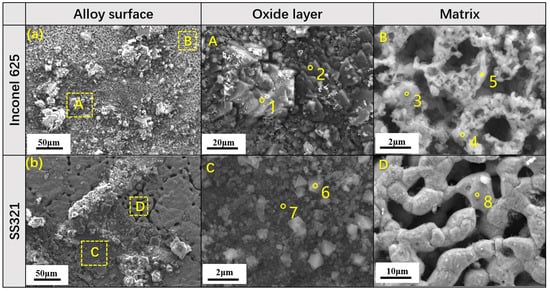
Figure 8.
SEM surface morphology characterization of alloys in NaCl–KCl–MgCl2 molten chlorides at 700 °C. (a) Inconel 625; (b) SS321.
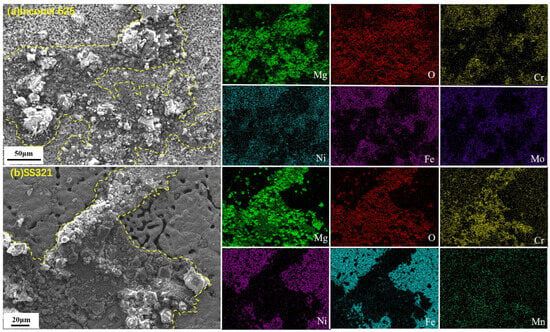
Figure 9.
EDS of surface morphology characterization of alloys in NaCl–KCl–MgCl2 molten chlorides at 700 °C. (a) Inconel 625; (b) SS321.

Table 4.
EDS Point scanning of alloys in molten chlorides at 700 °C in Figure 8 (at%).
As shown in Figure 8b, the corrosion product layer of SS321 also exhibits a typical bilayer structure. The outer layer is composed of loosely packed irregular particles, while the inner layer consists of a relatively dense oxide scale (Figure 8b-C). In region D of Figure 8b, the substrate is enriched in Fe and Ni, whereas Cr is completely depleted from the surface, as confirmed by the EDS result at point 8 in Table 4. According to the EDS analyses of Figure 8b and points 6 and 7 in Table 4, the outer corrosion products on the alloy surface are mainly composed of MgO, whereas the inner layer consists primarily of MgO with a minor amount of MgCr2O4.
Figure 10 presents the cross-sectional EDS elemental distribution of Inconel 625 and SS321 after exposure to molten MgCl2–NaCl–KCl at 700 °C. Compared with the intergranular corrosion observed in the binary NaCl–KCl environment, varying degrees of dissolution within the corrosion layer in both alloys are exhibited in the ternary salt environment, showing a behaviors similar to uniform corrosion behavior. Notably, in Inconel 625, Mo–Fe-rich particles are observed within the oxide scale, accompanied by Mo and Fe enrichment beneath the scale (Figure 10a), while Cr loss is no longer significant. This observation is consistent with the surface characterization results. The enrichment originates from the outward diffusion and dissolution of Cr into the molten salt, which generates vacancies in the alloy. As these vacancies accumulate, Mo, owing to its high corrosion resistance and extremely low diffusion rate, cannot migrate synchronously and thus becomes “retained” at the corrosion front, leading to its local enrichment. Although Fe is more mobile, it becomes the next primary reacting element after the extensive depletion of Cr, and together with Mo, forms the Fe–Mo co-enrichment zones [,,]. The Mo–Fe particles in the oxide layer contain less Fe than the Mo–Fe enriched regions on the alloy surface, indicating that these particles are remnants of the Mo–Fe enriched regions after corrosion. This process indicates that Mo exhibits higher corrosion resistance compared with Fe. The Mo enrichment beneath the oxide layer contributes to suppressing Cr depletion, thereby enhancing the long-term corrosion resistance of Inconel 625 [].
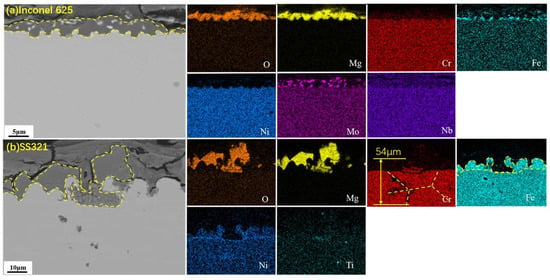
Figure 10.
SEM cross-section morphology characterization of alloys in NaCl–KCl-MgCl2 molten chlorides at 700 °C. (a) Inconel 625; (b) SS321.
The cross-sectional characterization of SS321, combined with surface analysis, further confirms the formation of a double-layer structure composed of MgO and MgCr2O4 on the alloy surface. The irregular morphology of the matrix indicates severe corrosion, and Cr is nearly completely depleted in the Fe-enriched regions. Beneath the Fe-rich zones, intergranular corrosion is still observed, with the Cr-depleted layer reaching a depth of approximately 54 µm (Figure 10b). Compared with the binary salt environment, the Cr-depletion depth in SS321 under the ternary molten salt is relatively smaller, yet the corrosion rate is higher (Figure 3). This is attributed to the absence of Mo in SS321. After Cr depletion, Fe becomes the next major reactive element, and the Fe-enriched regions are mainly formed as a result of Cr loss. However, in the absence of Mo, these Fe-rich regions provide only limited corrosion resistance. Consequently, the corroded matrix is directly exposed to chlorination or oxidation, thereby accelerating the corrosion rate in the ternary environment.
Based on the combined surface and cross-sectional characterizations, both alloys form a single-layer corrosion product structure after exposure to molten MgCl2–NaCl–KCl, indicating that the corrosion process is primarily governed by oxide film growth and elemental migration. On Inconel 625, the surface is mainly covered by MgO, while cross-sectional analysis reveals Mo and Fe enrichment near the substrate. Although Cr2O3 is unstable in the ternary molten salt, the presence of Mo slows down Cr depletion, helping to maintain the local structural integrity and resulting in relatively mild corrosion. In contrast, the corrosion layer of SS321 is composed mainly of MgO and MgCr2O4. When Cr depletes rapidly, the corrosion layer is loose with poor structural integrity, and the cross-section exhibits typical grain boundary failure, exhibiting more severe corrosion. Although both alloys undergo surface oxidation and elemental migration, Inconel 625 exhibits a slower and more stable corrosion evolution, whereas SS321 shows accelerated degradation due to rapid grain boundary rupture.
4. Discussion
4.1. Corrosion Mechanism of Inconel 625 in Molten Salts
In high-temperature molten salt environments, the NaCl–KCl binary system exhibits relatively mild corrosivity due to the absence of highly hygroscopic MgCl2. Under continuous high-purity argon flow, the water and oxidizing species available for corrosion reactions are minimal, and the residual moisture mainly originates from salt preparation or environmental adsorption. Consequently, the generated H+ and O2− concentrations are low, and the corrosion process primarily manifests as slow oxidation. The corrosion products generally form a relatively dense, double-layer oxide structure, which can partially inhibit further degradation. In contrast, the MgCl2–NaCl–KCl ternary system is highly hygroscopic; even under high-purity argon, it reacts with moisture to form MgCl2·nH2O, which decomposes at 700 °C to produce MgOHCl and HCl. The former releases Mg2+, O2−, and H+, while the latter reacts with residual oxygen to generate Cl2 [,,], The relevant reactions can be described as:
It should be noted that MgO detected in the ternary MgCl2–NaCl–KCl system may have dual origins. On one hand, MgO can be formed at the beginning of the experiment through the thermal hydrolytic decomposition of residual MgCl2·nH2O. On the other hand, MgO can also be incorporated into the corrosion scale during alloy–salt interactions, particularly on Inconel 625. Therefore, MgO is not solely a decomposition product of the salt medium but also participates in the corrosion processes. These reaction products significantly enhance the oxidizing and acidic nature of the molten salt, accelerating the oxidation and dissolution of active elements such as Cr and Fe, thereby increasing the overall corrosivity of the ternary system.
In high-temperature molten salt environments, the oxidation tendencies of alloying elements can be evaluated thermodynamically using Gibbs free energy (ΔG), which helps to elucidate the corrosion mechanisms. HSC 6.0 calculations, shown in Figure 11, indicate that in the NaCl–KCl binary salt, the primary oxidizing impurities are generated from trace water, producing HCl and O2. Chromium exhibits a significantly lower ΔG than Fe and Ni, making it the preferentially oxidized element in both alloys. In the MgCl2–NaCl–KCl ternary salt, the oxidizing species are more abundant and aggressive; however, Ni and Mo in Inconel 625 possess higher oxidation stability than Cr, exhibiting higher ΔG values that suppress ongoing corrosion.
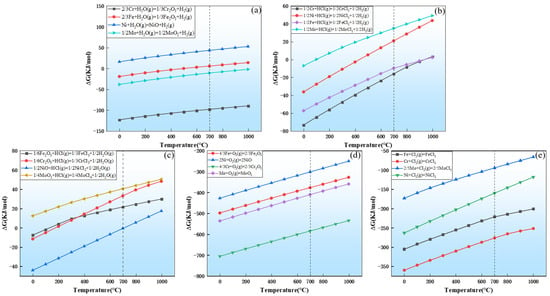
Figure 11.
Temperature dependence of Gibbs free energy of metal oxidation and chlorination calculated by HSC6.0, (a) M + H2O(g) = MxOy + H2(g); (b) M + HCl(g) = MClx + H2; (c) MxO + HCl(g) = MxCly + H2O; (d) M + O2(g) = MxOy; (e) M + Cl2(g) = MClx.
Figure 12 illustrates the corrosion mechanism of Inconel 625 exposed at 700 °C to NaCl–KCl binary salt and MgCl2–NaCl–KCl ternary salt. In NaCl–KCl, the alloy surface initially forms a corrosion product layer dominated by Cr2O3, driven by the thermodynamic preference for Cr oxidation (ΔG(Cr2O3) < ΔG(NiO)) and the rapid outward diffusion of Cr along grain boundaries toward the surface. Cr rapidly diffuses along grain boundaries and oxidizes at the surface, generating a dense Cr2O3 layer that transiently impedes further penetration of corrosive species. The formation of this protective Cr2O3 film involves nucleation of oxide at active sites, growth through the inward diffusion of oxygen and outward diffusion of Cr, and coalescence of oxide grains to form a continuous barrier. However, the Cr2O3 film is prone to cracking or spallation, leading to continued Cr migration and oxidation in exposed areas, ultimately forming a pronounced Cr-depleted zone within the substrate. As Cr is depleted, NiO forms in the inner layer and reacts with Cr2O3 to produce a NiCr2O4 inner oxide layer (Cr2O3 + NiO → NiCr2O4), which contributes to the formation of a more stable inner protective film. Meanwhile, trace Fe in the alloy also diffuses to the surface, reacting with residual H2O or O2 under extremely low oxygen conditions to form Fe3O4 or participate in the formation of complex oxides such as FeCr2O4. Overall, in the binary salt, corrosion is dominated by high-temperature oxidation, primarily along grain boundaries. The preferential outward diffusion and continuous depletion of Cr along the grain boundaries result in formation of Cr-depleted zones, significantly reducing corrosion resistance and promoting rapid intergranular attack.
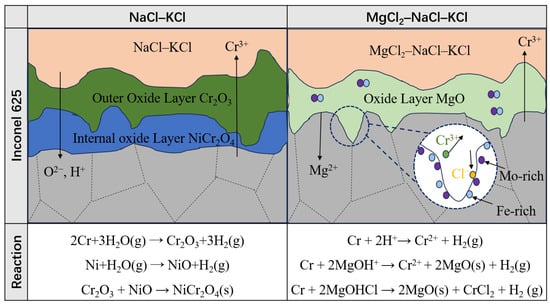
Figure 12.
Corrosion mechanism of Inconel 625 at 700 °C in molten salts.
In contrast, the corrosion rate of Inconel 625 in the more aggressive MgCl2–NaCl–KCl ternary salt is significantly reduced. Due to the strong hygroscopicity and hydrolysis of MgCl2, the generated HCl and H2O react with Cr, causing Cr to dissolve as Cr2+, which further reacts with MgOH− to produce Cr2+ and MgO. During oxidation, Cr initially forms Cr2O3; however, MgO exhibits higher thermodynamic stability, and the combined effect of Mg2+ and O2− produced from hydrolysis in the ternary molten salt promotes the deposition of MgO, which replaces Cr2O3 as the dominant corrosion product. Unlike the corrosion process in the binary salt, the ternary salt environment leads to the formation of Fe–Mo-enriched regions within the corrosion layer as Cr is gradually depleted. This phenomenon can be explained by elemental diffusion during corrosion. High-temperature hydrolysis of MgCl2 generates HCl and H2O, enhancing the acidity and Cl− activity of the molten salt, which facilitates selective Cr dissolution (Cr + 2H+ → Cr2+ + H2↑) and its removal via reaction with MgOH+, rapidly forming Cr-depleted zones. This creates favorable conditions for the redistribution of Fe and Mo. Owing to its high thermodynamic stability and low diffusion rate, Mo cannot migrate easily during substantial Cr depletion and therefore accumulates at the interface. The relatively dense MgO deposition further limits the outward diffusion of Mo, promoting the formation of localized Fe–Mo co-enriched regions, which contributes to improved corrosion resistance of Inconel 625. Previous studies have also emphasized that Mo enrichment contributes to stabilizing the passive layer and mitigating rapid Cr depletion, which is consistent with the corrosion resistance mechanism observed in Inconel 625 in this work [].
In the binary molten salt, the absence of MgCl2 and its hydrolysis products results in a relatively mild corrosive environment, significantly reducing the dissolution rate of Cr. Consequently, the corrosion behavior of Inconel 625 is dominated by gradual intergranular corrosion, and no Fe–Mo enrichment is observed. In the ternary molten salt, the formation of Mo–Fe enriched regions plays a critical role in suppressing Cr loss, while the formation of thermodynamically stable MgO also provides a degree of protection. The role of MgCl2 is not solely to accelerate the corrosion of Inconel 625; rather, the combined effect of stable MgO formation and the development of Mo-enriched zones mitigates the corrosion rate and enhances the alloy’s overall corrosion resistance in the ternary molten salt.
4.2. Corrosion Mechanism of SS321 in Molten Salts
Thermodynamic calculations in Figure 11 indicate that Cr is the preferentially oxidized element in SS321 in both molten salts. However, due to the substantially higher Fe content compared to Cr, Fe also undergoes preferential oxidation. In the ternary MgCl2–NaCl–KCl molten salt, which exhibits stronger oxidizing properties and contains more corrosive impurities, both Cr and Fe in SS321 are more susceptible to attack, with more negative ΔG values, indicating a higher oxidation tendency and rapid consumption under highly oxidizing conditions.
Figure 13 illustrates the corrosion mechanisms of SS321 at 700 °C in the binary NaCl–KCl and ternary MgCl2–NaCl–KCl molten salts. Initially, selective oxidation of Cr occurs on the alloy surface, forming a Cr2O3 layer driven by the strong oxidation tendency of Cr (ΔG(Cr2O3) < ΔG(Fe3O4) < ΔG(NiO)). During this stage, Cr atoms rapidly diffuse outward and react with O2−, generating a thin but discontinuous Cr2O3 layer. However, due to the presence of Cl− ions, the Cr2O3 film suffers from active dissolution and localized breakdown, which hinders its ability to grow into a dense and continuous protective barrier. Since the Cr2O3 layer cannot effectively block diffusion of the underlying elements, Fe2+/Fe3+ diffuses to the outermost layer to form Fe3O4. Subsequently, Ni undergoes further oxidation to form minor amounts of NiO, which are dispersed within the Cr2O3 matrix, resulting in a loose and heterogeneous outer oxide layer with poor overall density. Moreover, corrosion propagates along the grain boundaries, forming a mixed transgranular–intergranular corrosion path. Black corrosion channels penetrate along the grain boundaries, indicating severe structural damage and preventing stable formation and growth of the protective oxide layer, thus exhibiting pronounced and irreversible intergranular corrosion behavior. This observation is consistent with the EBSD results shown in Figure 2. SS321 exhibits smaller and unevenly distributed grains with localized stress concentrations at certain grain boundaries, which can act as initiation sites for intergranular corrosion and accelerate its propagation along the boundaries. In contrast, Inconel 625 features relatively large and uniformly distributed grains with predominantly high-angle grain boundaries and low boundary stresses, promoting the formation of stable protective oxide layers and reducing preferential corrosion along grain boundaries.
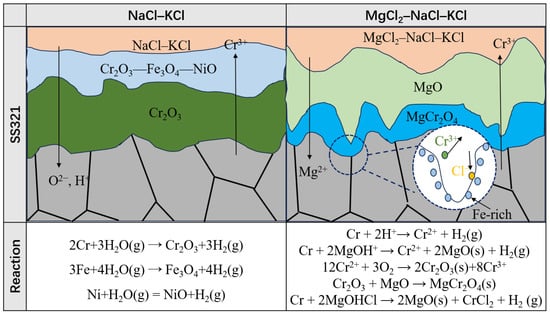
Figure 13.
Corrosion mechanism of SS321 at 700 °C in molten salts.
In contrast, in the ternary molten salt, the initial corrosion of SS321 also begins with the formation of Cr2O3. However, the strong hygroscopicity of MgCl2 and the hydrolysis products significantly enhance the acidity and Cl− activity of the molten salt, undermining the stability of Cr2O3 and causing partial dissolution of Cr. Simultaneously, the abundant Mg2+ ions deposit on the Cr2O3 surface to form MgO, which subsequently reacts in the solid state according to Cr2O3 + MgO → MgCr2O4, transforming the original Cr2O3 into a spinel-type MgCr2O4. This process consumes Cr2O3, leading to a loose oxide structure that hinders the continuous formation and stabilization of a dense protective layer. Consistent with our findings, Zhang et al. reported that Fe-based steel (A709) and stainless steel (SS316) also underwent rapid Cr depletion in MgCl2-containing environments, resulting in the inability to sustain protective oxide films []. Furthermore, unlike Inconel 625, where Mo-rich regions form stable Mo–Fe zones, the Fe-enriched barrier layer formed in SS321 after Cr loss fails to effectively impede corrosion. The underlying substrate remains exposed to the corrosive environment, allowing further attack by Cl− and even intergranular corrosion.
Liu et al. reported that, after 100 h immersion in molten NaCl–MgCl2–KCl in vacuum at 700 °C, Ni-based alloys generally exhibited lower corrosion rates than common stainless steels, with Inconel 625 showing a corrosion rate of 3942 µm/y compared with 316L (11,388 µm/y) and 304 (20,148 µm/y) []. Consistent with these findings, our results confirm the superior baseline resistance of Ni-based alloys in chloride melts. In the present study, however, under 250 h exposure and the specific salt compositions tested, the measured corrosion rates differ markedly among alloys and salts: Inconel 625 recorded 786.30 µm/y in NaCl–KCl and 85.71 µm/y in MgCl2–NaCl–KCl, whereas SS321 showed 2143.38 µm/y and 2835.51 µm/y, respectively. These data indicate that molten salt composition and testing conditions strongly modulate corrosion kinetics. In the binary molten salt system, the absence of the strong hydrolysis effect of MgCl2 results in a relatively mild corrosive environment, significantly slowing the dissolution rate of Cr in SS321. In the ternary molten salt, the high activity of HCl and O2− accelerates Cr depletion, and the lack of stable elements such as Mo in SS321 fails to mitigate this loss, leading to a corrosion rate markedly higher than in the binary salt. This results in severe intergranular attack and a pronounced tendency toward material failure. In contrast, Inconel 625 benefits from the dense single-layer MgO on its surface and the stabilizing effect of Mo, effectively suppressing Cr loss and intergranular corrosion, thereby exhibiting superior corrosion resistance.
5. Conclusions
This study investigates the corrosion behavior of two typical alloys, Inconel 625 and SS321, in NaCl–KCl and MgCl2–NaCl–KCl molten salt environments at 700 °C. The comparative results provide novel evidence that can guide the selection of structural materials for next-generation energy systems employing chloride molten salts. The main conclusions are as follows:
- (1)
- In binary molten salt, Inconel 625 undergoes sequential oxidation where Cr preferentially forms an outer Cr2O3 layer, followed by Ni oxidation generating an inner NiCr2O4 layer. Prolonged Cr depletion leads to Cr-depleted zones and intergranular corrosion. In contrast, in the ternary salt system, MgO replaces Cr2O3 as the dominant corrosion product. This is accompanied by Mo enrichment near the surface, which provides localized protection and collectively contributes to superior corrosion resistance compared to the binary salt environment.
- (2)
- When SS321 is exposed to binary molten salt, Cr preferentially oxidizes to form Cr2O3, followed by Fe and Ni oxidation producing a mixed, porous oxide layer, making grain boundaries susceptible to corrosion and damage. In ternary system, Cr2O3 is unstable and reacts with MgO to form loose MgCr2O4. Lacking stable elements such as Mo to provide support, an effective protective barrier cannot form, leading to rapid Cr depletion, severe grain boundary degradation, and a corrosion rate higher than in the binary salt environment.
- (3)
- The corrosion rate of Inconel 625 is 786.30 µm/y in the binary salt, which further decreases to 85.71 µm/y in the ternary salt. In contrast, SS321 shows much higher corrosion rates of 2143.38 µm/y in NaCl–KCl and 2835.51 µm/y in MgCl2–NaCl–KCl. Although MgCl2 increases the corrosivity of the molten salt, the H+, O2−, and Cl2 generated during its hydrolysis accelerate Cr dissolution, simultaneously promoting Mo enrichment in Inconel 625, enhancing its corrosion resistance. In contrast, in SS321, which lacks corrosion-resistant elements, MgCl2 primarily accelerates Cr depletion and structural degradation.
Author Contributions
H.H.: contributed to conceptualization, methodology, visualization, writing original draft. X.Z.: contributed to conceptualization, funding acquisition, methodology, supervision, writing—review & editing. T.H.: contributed to data curation, writing—review & editing. R.Y.: contributed to methodology, supervision, writing—review & editing. K.W.: contributed to funding acquisition. All authors have read and agreed to the published version of the manuscript.
Funding
This work was supported by the National Natural Science Foundation of Hubei Province (2025AFB516), the Guangdong Basic and Applied Basic Research Foundation (2023A1515240085), and the National Natural Science Foundation of China (22309140), which are highly acknowledged. We also would like to thank the Analytical & Testing Center of Wuhan University of Science and Technology for the help in the experiments.
Data Availability Statement
All data needed to evaluate the conclusions are present in the paper. The raw data supporting the conclusions of this article will be made available by the authors upon request.
Conflicts of Interest
The author declare that they have no competing financial interests.
References
- Myers, P.D.; Goswami, D.Y. Thermal energy storage using chloride salts and their eutectics. Appl. Therm. Eng. 2016, 109, 889–900. [Google Scholar] [CrossRef]
- Henry, A.; Prasher, R. The prospect of high temperature solid state energy conversion to reduce the cost of concentrated solar power. Energy Environ. Sci. 2014, 7, 1819–1828. [Google Scholar] [CrossRef]
- Roeb, M.; Neises, M.; Monnerie, N.; Sattler, C.; Pitz-Paal, R. Technologies and trends in solar power and fuels. Energy Environ. Sci. 2011, 4, 2503–2511. [Google Scholar] [CrossRef]
- Villada, C.; Ding, W.; Bonk, A.; Bauer, T. Engineering molten MgCl2–KCl–NaCl salt for high-temperature thermal energy storage: Review on salt properties and corrosion control strategies. Sol. Energy Mater. Sol. Cells 2021, 232, 111344. [Google Scholar] [CrossRef]
- Sohal, M.S.; Ebner, M.A.; Sabharwall, P.; Sharpe, P. Engineering Database of Liquid Salt Thermos-Physical and Thermochemical Properties; No. INL/EXT-10-18297; Idaho National Laboratory (INL): Idaho Falls, ID, USA, 2010. [CrossRef]
- Kearney, D.; Herrmann, U.; Nava, P.; Kelly, B.; Mahoney, R.; Pacheco, J.; Cable, R.; Blake, D.; Price, H. Assessment of a molten salt heat transfer fluid in a parabolic trough solar field. J. Sol. Energy Eng. 2003, 125, 170–176. [Google Scholar] [CrossRef]
- Fu, D.; Zhang, C.; Wang, G.; Na, H.; Wu, Y. An update review of molecular dynamic study on thermal physical properties of molten salt. Sol. Energy Mater. Sol. Cells. 2024, 273, 112916. [Google Scholar] [CrossRef]
- Xu, X.; Wang, X.; Li, P.; Li, Y.; Hao, Q.; Xiao, B.; Elsentriecy, H.; Gervasio, D. Experimental test of properties of KCl–MgCl2 eutectic molten salt for heat transfer and thermal storage fluid in concentrated solar power systems. J. Sol. Energy Eng. 2018, 140, 051011. [Google Scholar] [CrossRef]
- Wei, X.; Song, M.; Wang, W.; Ding, J.; Yang, J. Design and thermal properties of a novel ternary chloride eutectics for high-temperature solar energy storage. Appl. Energy. 2015, 156, 306–310. [Google Scholar] [CrossRef]
- Mehos, M.; Turchi, C.; Vidal, J.; Wagner, M.; Ma, Z.; Ho, C.; Kolb, W.; Andraka, C.; Kruizenga, A. Concentrating Solar Power Gen3 Demonstration Roadmap; National Renewable Energy Laboratory (NREL): Golden, CO, USA, 2017. [CrossRef]
- Vidal, J.C.; Klammer, N. Molten chloride technology pathway to meet the U.S. DOE SunShot initiative with Gen3 CSP. AIP Conf. Proc. 2019, 2126, 080006. [Google Scholar] [CrossRef]
- Vignarooban, K.; Xu, X.; Arvay, A.; Hsu, K.; Kannan, A.M. Heat transfer fluids for concentrating solar power systems—A review. Appl. Energy. 2015, 146, 383–396. [Google Scholar] [CrossRef]
- Serrano-López, R.; Fradera, J.; Cuesta-López, S. Molten salts database for energy applications. Chem. Eng. Process. Process Intensif. 2013, 73, 87–102. [Google Scholar] [CrossRef]
- Li, Y.; Xu, X.; Wang, X.; Li, P.; Hao, Q.; Xiao, B. Survey and evaluation of equations for thermophysical properties of binary/ternary eutectic salts from NaCl, KCl, MgCl2, CaCl2, ZnCl2 for heat transfer and thermal storage fluids in CSP. Sol. Energy 2017, 152, 57–79. [Google Scholar] [CrossRef]
- Sergeev, D.; Kobertz, D.; Müller, M. Thermodynamics of the NaCl–KCl system. Thermochim. Acta. 2015, 606, 25–33. [Google Scholar] [CrossRef]
- Ding, W.; Bonk, A.; Bauer, T. Corrosion behavior of metallic alloys in molten chloride salts for thermal energy storage in concentrated solar power plants: A review. Front. Chem. Sci. Eng. 2018, 12, 564–576. [Google Scholar] [CrossRef]
- Gong, Q.; Shi, H.; Chai, Y.; Yu, R.; Weisenburger, A.; Wang, D.; Bonk, A.; Bauer, T.; Ding, W. Molten chloride salt technology for next-generation CSP plants: Compatibility of Fe-based alloys with purified molten MgCl2–KCl–NaCl salt at 700 °C. Appl. Energy. 2022, 324, 119708. [Google Scholar] [CrossRef]
- Hu, S.; Finklea, H.; Liu, X. A review on molten sulfate salts induced hot corrosion. J. Mater. Sci. Technol. 2021, 90, 243–254. [Google Scholar] [CrossRef]
- Wang, Y.; Liu, H.; Yu, G.; Hou, J.; Zeng, C. Electrochemical study of the corrosion of a Ni-based alloy GH3535 in molten (Li, Na, K) F at 700 °C. J. Fluor. Chem. 2015, 178, 14–22. [Google Scholar] [CrossRef]
- Sun, H.; Wang, J.; Li, Z.; Zhang, P.; Su, X. Corrosion behavior of 316SS and Ni-based alloys in a ternary NaCl–KCl–MgCl2 molten salt. Sol. Energy. 2018, 171, 320–329. [Google Scholar] [CrossRef]
- Xu, Z.; Guan, B.; Wei, X.; Lu, J.; Ding, J.; Wang, W. High-temperature corrosion behavior of Inconel 625 alloy in a ternary molten salt of NaCl–CaCl2–MgCl2 in air and N2. Sol. Energy. 2022, 238, 216–225. [Google Scholar] [CrossRef]
- Yu, R.; Gong, Q.; Shi, H.; Chai, Y.; Bonk, A.; Weisenburger, A.; Wang, D.; Müller, G.; Bauer, T.; Ding, W. Corrosion behavior of Fe-Cr-Ni based alloys exposed to molten MgCl2–KCl–NaCl salt with over-added Mg corrosion inhibitor. Front. Chem. Sci. Eng. 2023, 17, 1608–1619. [Google Scholar] [CrossRef]
- Liu, Q.; Xu, H.; Yin, H.; Li, N.; Wang, W.; Li, L.; Tang, Z.; Qian, Y. Corrosion behaviour of 316 stainless steel in NaCl–KCl–MgCl2 salt vapour at 700 °C. Corros. Sci. 2022, 194, 109921. [Google Scholar] [CrossRef]
- Shankar, V.; Bhanu Sankara Rao, K.; Mannan, S.L. Microstructure and mechanical properties of Inconel 625 superalloy. J. Nucl. Mater. 2001, 288, 222–232. [Google Scholar] [CrossRef]
- Li, S.; Wei, Q.; Shi, Y.; Zhu, Z.; Zhang, D. Microstructure characteristics of Inconel 625 superalloy manufactured by selective laser melting. J. Mater. Sci. Technol. 2015, 31, 946–952, Erratum in J. Mater. Sci. Technol. 2016, 32, e1. https://doi.org/10.1016/j.jmst.2016.06.009. [Google Scholar] [CrossRef]
- de Oliveira, M.M.; Couto, A.A.; Almeida, G.F.C.; Reis, D.A.P.; de Lima, N.B.; Baldan, R. Mechanical behavior of Inconel 625 at elevated temperatures. Metals 2019, 9, 301. [Google Scholar] [CrossRef]
- Gumma, S.; Roychowdhury, S. Effect of solution annealing treatment parameters on sensitization behavior of SS321. J. Mater. Eng. Perform. 2025, 34, 2227–2241. [Google Scholar] [CrossRef]
- Manokaran, M.; Kashinath, A.S.; Jha, J.S.; Toppo, S.P.; Singh, R. Understanding the stress rupture behavior and microstructural changes in austenitic stainless steel SS321. J. Mater. Eng. Perform. 2021, 30, 9165–9180. [Google Scholar] [CrossRef]
- Pownceby, M.I.; Jenkins, D.H.; Ruzbacky, R.; Saunders, S. Preparation of anhydrous magnesium chloride: Solid–liquid phase diagram for the system MgCl2–NH3–C2H4[OH]2 at 323 K. J. Chem. Eng. Data 2012, 57, 2855–2862. [Google Scholar] [CrossRef]
- Rammelberg, H.U.; Schmidt, T.; Ruck, W. Hydration and dehydration of salt hydrates and hydroxides for thermal energy storage—Kinetics and energy release. Energ. Procedia 2012, 30, 362–369. [Google Scholar] [CrossRef]
- Zhang, M.; Leong, A.; Ren, J.; Zhang, J. Corrosion kinetics of pure metals (Fe, Cr, Ni) and alloys (A709, SS316) in thermal and chemical purified molten chloride salt. RSC Adv. 2025, 15, 19013–19022. [Google Scholar] [CrossRef]
- Lee, U.; Kim, M.W.; Na, J.; Lee, M.; Kim, S.J.; Kim, D.-J.; Yoon, Y.S. A study on the corrosion behavior of Fe/Ni-based structural materials in unpurified molten chloride salt. Materials. 2025, 18, 1653. [Google Scholar] [CrossRef]
- Liu, S.; Wang, R.; Wang, L.; Ge, F.; Gao, M.; Si, Y.; Li, B. Corrosion behavior of iron-based and Ni-based alloys melted in NaCl–MgCl2–KCl mixed molten salt under vacuum atmosphere. J. Mater. Res. Technol. 2024, 28, 1915–1923. [Google Scholar] [CrossRef]
- Huang, T.; Yu, R.; Zhang, X.; Gao, B.; Yue, S.; Hu, H.; Wu, K. Hot corrosion behavior of Fe-Cr-Ni based alloys in molten chlorides using Ti as purification agent. J. Alloys Compd. 2025, 1031, 181046. [Google Scholar] [CrossRef]
- Gertsman, V.Y.; Bruemmer, S.M. Study of grain boundary character along intergranular stress corrosion crack paths in austenitic alloys. Acta Mater. 2001, 49, 1589–1598. [Google Scholar] [CrossRef]
- Gao, B.; Yu, R.; Chen, S.; Hu, H.; Wu, K.; Zhang, X. Corrosion behavior of surface-modified Ni-based alloys in molten NaCl–KCl for thermal energy storage. Mater. Chem. Phys. 2025, 332, 130288. [Google Scholar] [CrossRef]
- Liu, Q.; Wang, Z.; Liu, W.; Yin, H.; Tang, Z.; Qian, Y. Ni-Mo-Cr alloy corrosion in molten NaCl–KCl–MgCl2 salt and vapour. Corros. Sci. 2021, 180, 109183. [Google Scholar] [CrossRef]
- Chi, L.; Sun, H.; Zhou, X. Effects of alloying elements (Mo and W) on corrosion behavior of Ni-based alloys in NaCl–KCl–MgCl2 molten salt. Corros. Sci. 2024, 237, 112313. [Google Scholar] [CrossRef]
- Ding, W.; Shi, H.; Xiu, Y.; Bonk, A.; Weisenburger, A.; Jianu, A.; Bauer, T. Hot corrosion behavior of commercial alloys in thermal energy storage material of molten MgCl2/KCl/NaCl under inert atmosphere. Sol. Energy Mater. Sol. Cells. 2018, 184, 22–30. [Google Scholar] [CrossRef]
Disclaimer/Publisher’s Note: The statements, opinions and data contained in all publications are solely those of the individual author(s) and contributor(s) and not of MDPI and/or the editor(s). MDPI and/or the editor(s) disclaim responsibility for any injury to people or property resulting from any ideas, methods, instructions or products referred to in the content. |
© 2025 by the authors. Licensee MDPI, Basel, Switzerland. This article is an open access article distributed under the terms and conditions of the Creative Commons Attribution (CC BY) license (https://creativecommons.org/licenses/by/4.0/).